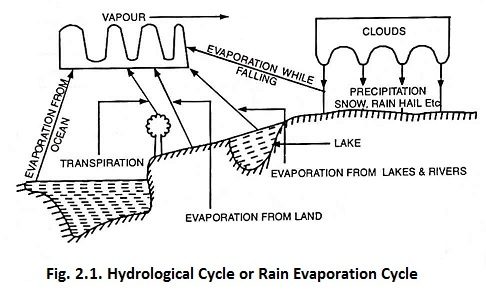Hydrological Cycle or Rain Evaporation Cycle:
Hydrological Cycle or Rain Evaporation Cycle is a process by which moisture from the surface of water bodies covering the earth’s surface transferred to the land and back to the water bodies again. This hydrological cycle is shown in Fig. 2.1.
The input to this hydrological cycle is the solar energy. Due to this water from the water bodies evaporates and on cooling these water vapours form clouds. Further cooling makes the clouds to fall down in the form of rain, snow, hail or sleet etc. known as precipitation. Precipitation includes all water that falls from the atmosphere to the earth’s surface in any form.
Major portion (about 2/3rd) of this precipitation, which reaches the land surface is returned to the atmosphere by evaporation from water surfaces, soil and vegetation and through transpiration by plants. The remaining precipitation returns ultimately to the sea or ocean through surface or underground channels. Thus cycle is completed.
The amount of rainfall which runs off the earth’s land surface to form streams or rivers is useful for generation of electric power. The precipitation that falls on hills and mountains in the form of snow, melts during warmer weather as run-off and converges to form streams can also be used for power generation.
